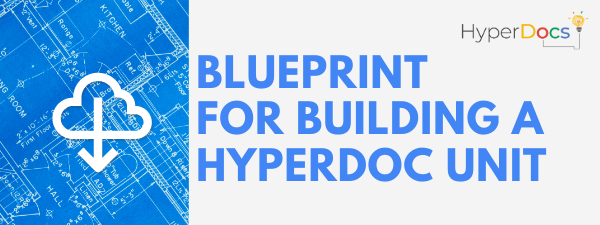BluePrint for Building a HyperDoc unit for Remote Learning
At the time of writing this, there are so many questions up in the air. Will we return to the classroom full time this coming school year? Will it be a hybrid model where students come for a couple of days and learn remotely for the rest of the week? Or will we continue distance learning with the idea that it is no longer an emergency situation, but one where grades now count?

Download the, "Blueprint for Building a HyperDoc Unit" here.
While so much may seem out of your control, one thing you do have control over are your lessons. Regardless of the environment you are teaching in, a good HyperDoc Unit can be a powerful method of delivering instruction and something you can start preparing for now. Planning ahead can be critical to a successful transition from assigning to instructing.
Why units? If you are concerned about planning for in-class lessons PLUS online learning at the same time, creating HyperDoc units may be your solution. Consider choosing portions of your curriculum that would work well in an online environment and create a HyperDoc unit ahead of time.
Why HyperDocs? Rather than posting multiple tasks in a variety of locations, a HyperDoc packages all the parts of a complex unit in one organized location, supporting the needs of all learners in a remote environment. A HyperDoc can help support independent work when designed with students’ needs in mind.
Here are 5 considerations to think through while creating a HyperDoc unit:
Asynchronous vs. Synchronous learning
Looking back on the experiences you and your students went through, reflect on how you delivered your content. Did you do it live (synchronously) in a platform like Zoom, Meets, or Teams? Did you deliver content recorded, or using HyperDocs or assignments that could be accessed at any time (asynchronously)? Try using this document to reflect on this work. What worked well synchronously, what was best in an asynchronous environment, and what did you miss most about face to face instruction that just didn’t work for you during this time? Did you ask your students these questions to find out what worked best for them as learners? Doing this work prior to planning units will help ensure the units you design are crafted around student needs.
Selecting a topic
Think about content that is critical to your course. (Some districts identify it by essential standards, core literature, etc) Creating a unit using one of these topics could help ensure the content will stick beyond the time period you are instructing. You have the ability to create a rich document that allows students to explore the topic deeply, connect with the layers multiple times through experiences you craft, and provide an authentic space for the learning. In primary grades, many educators have shared that they are making units for their history strands, or Science units so those subjects don't get overlooked. Many English teachers have shared that novel studies work well in an asynchronous environment and are working to create HyperDoc units for the books they plan to teach with. Select a topic that will help offload some of the limited face time you may have with your students. Save in-class time for the lessons that really need you all together.
When selecting a topic, stop and consider how does this address anti-racist instruction? Take some time to explore what perspectives the standards are erasing. Research to find the history, the authors, the novels, the inventors of color whose stories are not being shared. For more information on how to do this work, explore these resources:
Facing History
How to Be an Antiracist Educator
Teaching Tolerance
Black Lives Matter at School
Packaging
The way you organize your unit can be crucial to its success. Imagine opening the HyperDoc as a student...would you know where to start, what to do, where to turn work in, and how to complete all of the tasks?
Putting all the pieces together in one place that is easy to follow will take some time to think through. But also taking time to plan all of those pieces so they become powerful learning experiences vs. just a digital worksheet. If you are using Google tools, consider a Doc vs. Slides or even a Site. If you are using Microsoft, One Note would be a great tool to package with an easy to follow flow.
Meeting the needs of all students can be accomplished with purposeful packaging and design to your unit. Improve executive functioning skills with all elements of the unit packaged in one place from beginning to end.
Explore these variations for inspiration:
|
Slides |
Docs |
Sites |
Workflow and Assessment
Pacing and workflow can be designed to not only meet your needs but also your students’. If the unit is really long and potentially overwhelming, keep the original HyperDoc as a view-only document that you add the next steps in the unit every few days. Include visual clues and text to help with pacing and timelines for completion. Build-in checkpoints along the way for formative assessment purposes. A link to a Google Form can be an effective way to check-in without having to look through all the students' HyperDocs. Providing feedback and assessments along the way can offer students the opportunity to revise and improve their work before submitting their final product. Include peer review options for final feedback in order to ensure authentic purpose to the work and to support learning outcomes through multiple perspectives.
Taking the time to build a quality unit will not only support you when school is in session and you may be juggling different spaces but also add the structure of instruction to digital work.
More Sample units to explore: